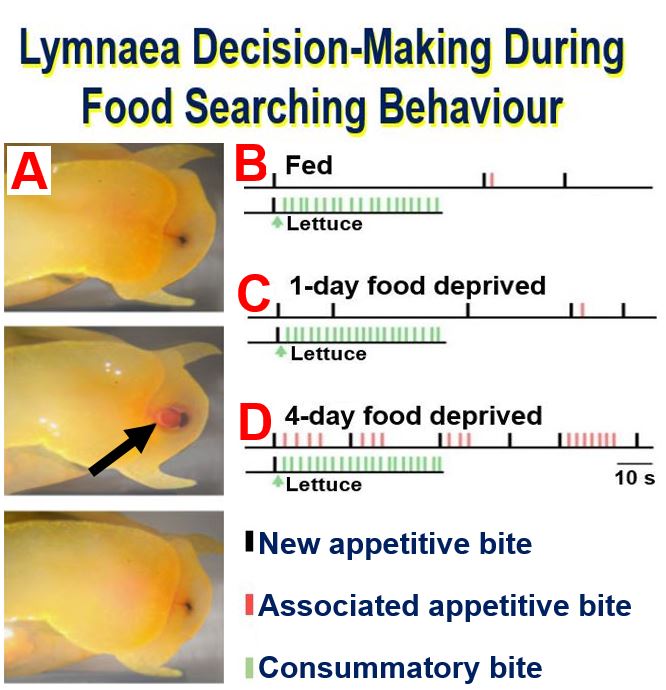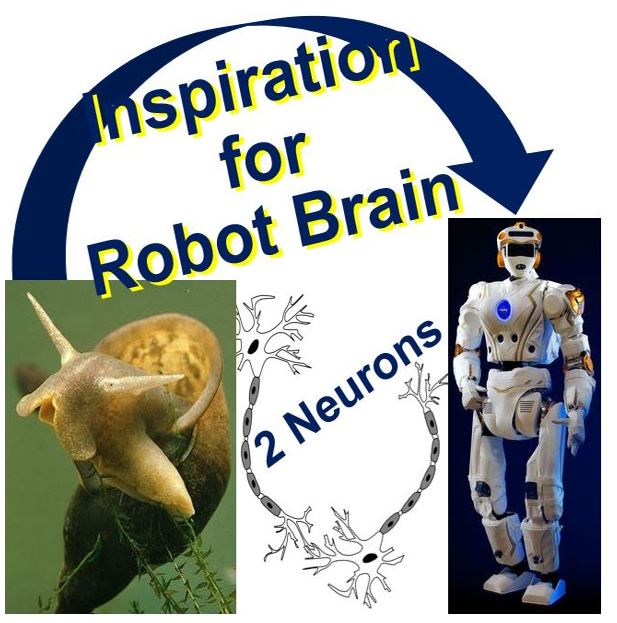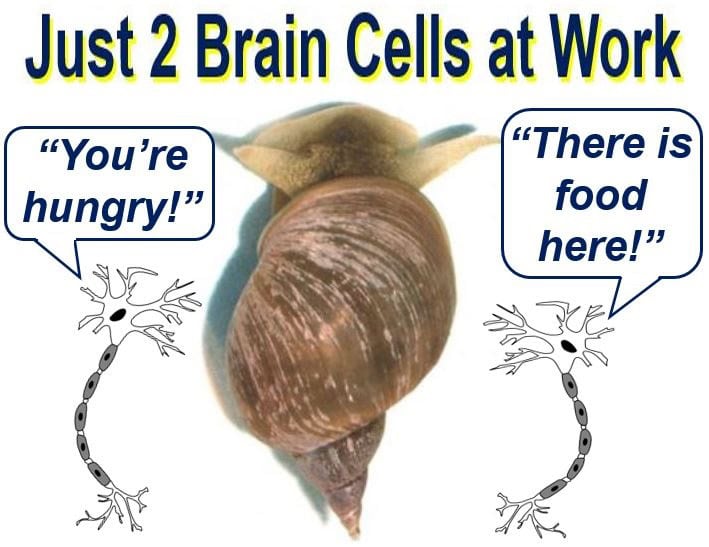With just two brain cells snails can make complex decisions, such as whether it is time to eat because they are hungry, or when and how to go about getting food, a feature that should be of great interest to roboticists when designing a robot’s brain, says a team of neuroscience researchers from the University of Sussex in England.
The snail’s two brain cells (neurons) can tell the mollusc when it is hungry and whether there is any food nearby.
When creating the artificial intelligence (AI) for a robot, i.e. its brain, engineers desire the fewest components possible for the maximum task performance, something the snail’s brain appears to do with amazing efficiency.
 Three photographs (A) of freshwater snail’s (Lymnaea’s) food-searching behaviour. (Top Frame) At water’s surface. (Middle Frame) Appetitive bite behaviour with open mouth and protraction of toothed radula (see black arrow). (Bottom Frame) Retraction of radula. The same basic motor pattern is used for ingestion when there is lettuce. (B to D) Example traces of Lymaea’s biting behaviour in the presence and absence of food at 3 different levels of satiety. (Image Source: Nature Communications)
Three photographs (A) of freshwater snail’s (Lymnaea’s) food-searching behaviour. (Top Frame) At water’s surface. (Middle Frame) Appetitive bite behaviour with open mouth and protraction of toothed radula (see black arrow). (Bottom Frame) Retraction of radula. The same basic motor pattern is used for ingestion when there is lettuce. (B to D) Example traces of Lymaea’s biting behaviour in the presence and absence of food at 3 different levels of satiety. (Image Source: Nature Communications)
Michael Crossley, Research Fellow (Neuroscience); George Kemenes, Professor of Neuroscience; and Kevin Staras, also a Professor of Neuroscience, all from the University of Sussex in Brighton, wrote about their study and findings in the journal Nature Communications.
In the journal they explain how they discovered that with only two brain cells, snails could make complex behavioural decisions.
What is a robot?
Snails’ amazing efficiency
The neuroscientists studied the brain activity of Lymnaea (freshwater snails) and discovered how a system consisting of just two neurons was capable of a sophisticated form of decision-making.
A neuron is a specialized cell that transmits nerve impulses; a nerve cell – the ones in the brain are also called brain cells.

The researchers, who work at Sussex Neuroscience, part of the University’s School of Life Sciences, monitored snail behaviour when they made decisions in their search for food, which in this study consisted of lettuce.
They recorded and measured the snails’ brain activity by using electrodes to gauge action potentials – slight electrical changes – in each individual neuron.
The authors said they discovered two types of neurons:
1. The control-type neuron: it tells the brain whether there is potential food in the vicinity.
2. Motivational state neuron: it tells the brain whether the animal is hungry or not.
Maximum performance with minimum of waste
Dr. Crossley and colleagues also explain how the snail’s 2- brain-cell system allows the creature to save energy by reducing brain activity to a minimum when there is no food.
Study leader, Prof. Kemenes, said regarding our knowledge of what goes on in our brains:
“What goes on in our brains when we make complex behavioural decisions and carry them out is poorly understood. Our study reveals for the first-time how just two neurons can create a mechanism in an animal’s brain which drives and optimizes complex decision making tasks.”
“It also shows how this system helps to manage how much energy they use once they have made a decision.”

Findings could inspire roboticists
The authors say that their findings could help engineers who are creating artificial intelligence (robot brains) identify core neuronal symptoms which drive other similar decision-making processes.
Regarding the creation of a robot’s brain, Prof. Kemenes explained:
“This will eventually help us design the ‘brains’ of robots based on the principle of using the fewest possible components necessary to perform complex tasks.”

All animals need to perform goal-directed behaviours, such as seeking food, in order to survive. When foraging (searching for food), their neuronal systems must integrate data from two areas:
1. The external environment.
2. Their internal state.
This needs to be done using as little energy as possible, i.e. ultra efficiently. Roboticists have the same goal in mind when designing a robot’s brain.
The authors made the following comment in an Abstract that describes the main paper:
“Using an in vitro analogue of the decision-making process, we show that the system employs an energy management strategy, switching between a low- and high-use mode depending on the outcome of the decision.”
“Our study reveals a parsimonious mechanism that drives a complex decision-making process via regulation of levels of tonic inhibition and phasic excitation.”
Journal Citation: “A two-neuron system for adaptive goal-directed decision-making in Lymnaea,” by Kevin Staras, Michael Crossley and György Kemenes – University of Sussex. Nature Communications. DOI:10.1038/ncomms11793.
Video – Snails Time-Lapse
Watch this amazing time-lapse BBC video of snails going about their business.
